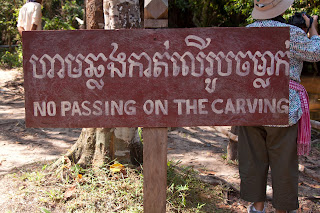We had lunch in a convenient open-air restaurant near the falls. Seeing that we looked like tourists (imagine that!) the staff were quick to bring a fan and position it so we would be comfortable. That gesture was much appreciated, as the temperatures had climbed to near 90 degrees and the humidity was higher.
After lunch we headed back down the mountain. We saw what we hope was a planned burning of the fields after harvest. If not, at least one structure was in danger.
Once out of the forest and crossing the agricultural area, we came across these boys doing what boys anywhere would do if they had a pond and a dugout canoe. There was a great deal of laughter and pointing to one of the boys who had foregone his pants for the adventure.
We soon arrived at another not-to-be-missed location.....Banteay Srei, a tenth century temple dedicated to the Hindu god Shiva. Made primarily of red sandstone, Banteay Srei is small in comparison to the other Angkor sites we visited. Originally the temple was called Tribhuvanamahesvar, meaning "great lord of the threefold world." Sometime later, it was rededicated and renamed Banteay Srei, translated as "Citadel of the Women" or "Citadel of Beauty."
The complex was rediscovered in 1914, and restoration began in the 1930s. The buildings of the temple complex are covered with intricate carvings, some of which are shown below.

After another scrumptious meal and a much-appreciated night's sleep, we traveled by tuk-tuk to catch our van for the trip home. We may have thought we were "roughing it" in our open-air carriage and in the crowded van. However, if we looked in any direction, we saw others whose mode of transportation made ours seem luxurious.























